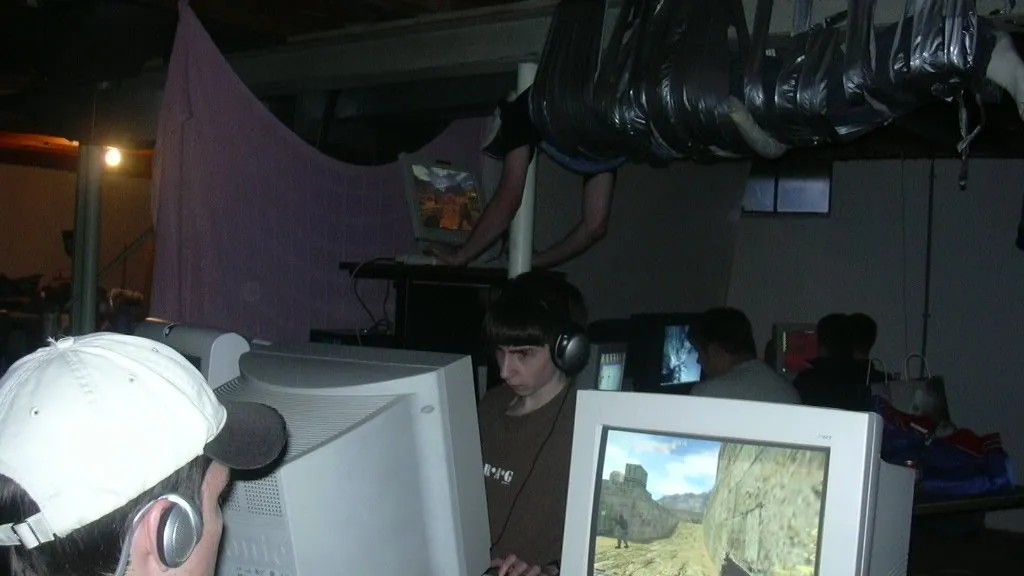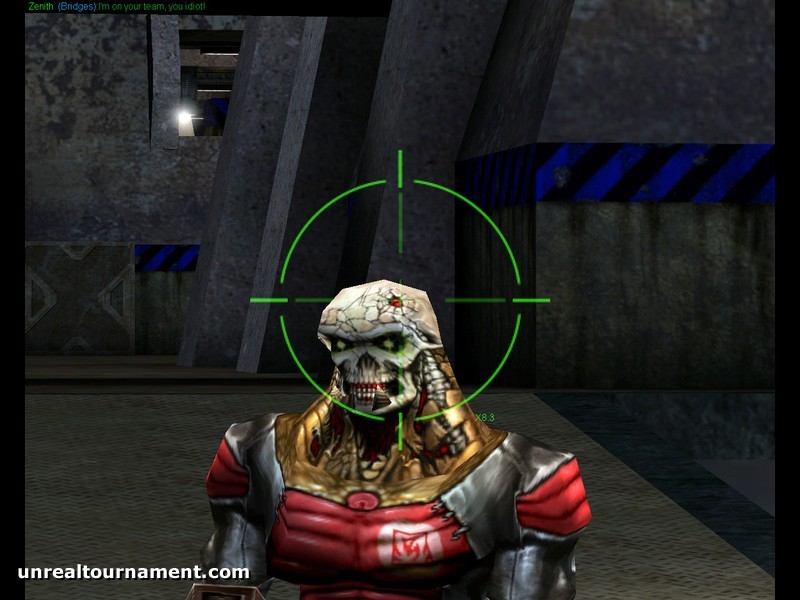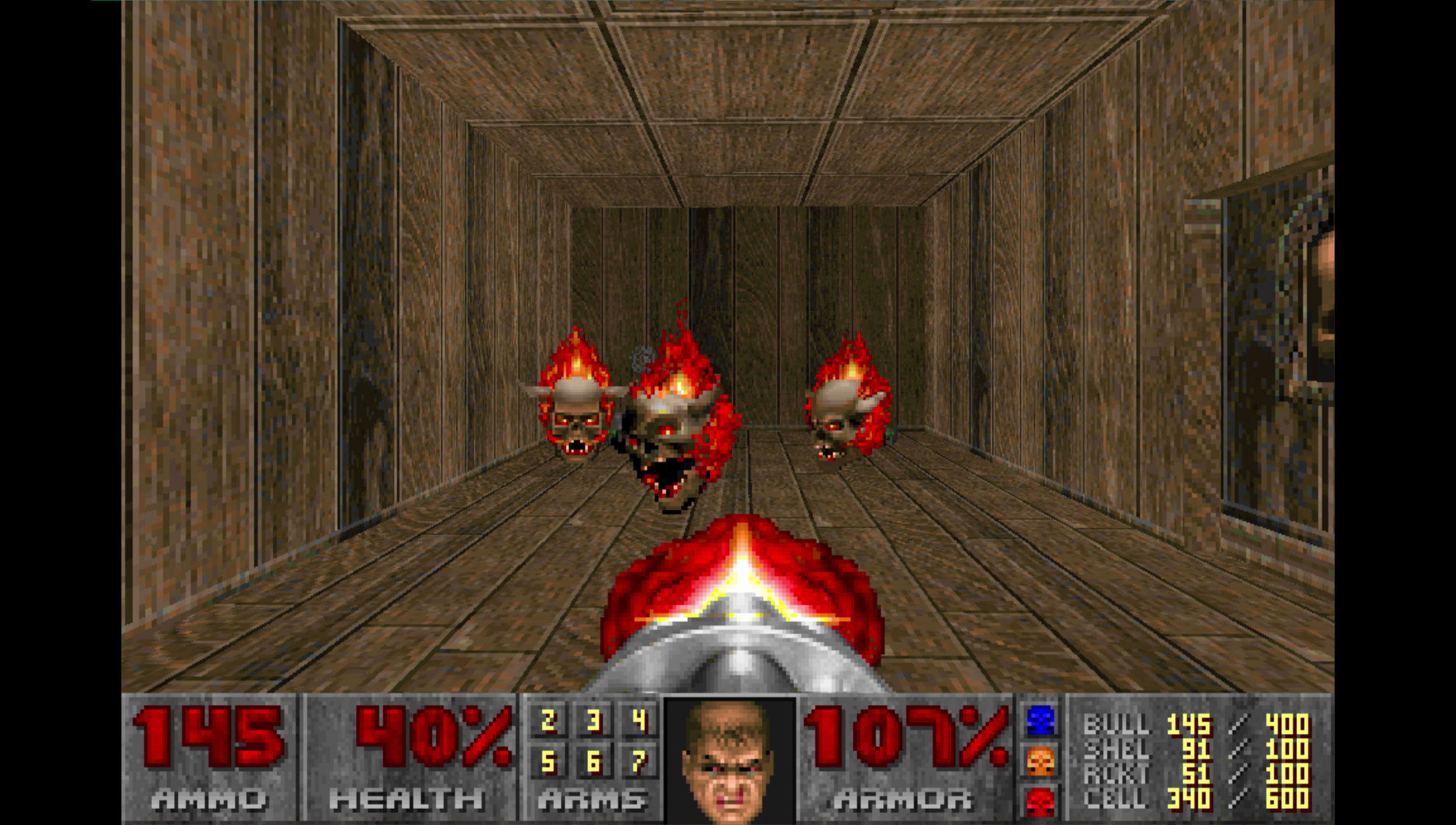In the early 1990s, as the World Wide Web began to weave its way into households, another revolution was taking place: the birth of the First-Person Shooter (FPS) genre in video gaming. FPS games, characterized by a perspective where players experience the game world through the eyes of their avatars, introduced a level of immersion previously unattained in video games.
This era was defined by the likes of Wolfenstein 3D and Doom games that, while primitive by today’s standards, were groundbreaking in their day. The simultaneous rise of FPS games and the Internet wasn’t mere coincidence. As more people connected online, the potential for a new kind of gaming experience became clear: one where players could compete not just with AI, but with other humans from around the world.
How Online Play Revolutionized Gaming: Setting the Stage for FPS
Before the advent of online multiplayer, video games were largely solitary or local multiplayer experiences. With the integration of Internet capabilities into gaming, players suddenly had the world at their fingertips, turning what used to be solitary experiences into global competitions and collaborations.
FPS games were especially suited for online play. The thrill of tracking and being tracked by a real opponent, the unpredictability of human strategy, and the satisfaction of a well-executed move were magnified tenfold when playing against real people. Games like Quake pioneered this format, offering a competitive arena for players to showcase their skills. This shift wasn’t just about competition; it was also about community. Gamers from different continents could form teams, strategize, and forge friendships that transcended borders.
From LAN Parties to Worldwide Battles: A Brief Overview
The transition from offline to online FPS gaming was not instantaneous. In the interim, gamers sought ways to play against each other in real-time, leading to the phenomenon of LAN (Local Area Network) parties. Players would lug their bulky desktop computers to a friend’s house or rented halls, connecting them to create a makeshift network.
Titles like Doom were favorites at these gatherings, with players battling it out in intense deathmatches. However, as Internet speeds improved and online gaming platforms became more sophisticated, the need for physical proximity diminished.
LAN parties gave way to online servers, where players could join battles from the comfort of their own homes, ushering in a new era of FPS gaming where battles were not just local but truly worldwide.

The Pioneer FPS Games on the Internet
Doom (1993): The Forerunner that Set the World on Fire
The Gameplay that Set Standards
Doom wasn’t just a game; it was a cultural phenomenon. Its gameplay introduced mechanics that would become mainstays in the FPS genre. Players navigated labyrinthine levels, collecting weapons and power-ups while battling an array of demonic enemies. The game’s 3D engine, albeit primitive by today’s standards, was groundbreaking, allowing for an immersive experience that gamers had never seen before. Its fast-paced, action-packed gameplay set the standard for what a first-person shooter should feel like.
The Rise of Online Multiplayer Doom Matches
While Doom was initially enjoyed as a single-player experience, it wasn’t long before gamers started using the early Internet and LANs to compete against one another. These multiplayer matches, termed ‘deathmatches’, saw players going head-to-head in frenetic battles, cementing Doom as not just an iconic single-player game but as a pioneer in multiplayer FPS gaming.
Quake (1996): A Leap in Internet Gaming

Revolutionizing Online Play with QuakeWorld
If Doom set the stage, Quake refined it. With its release, players were treated to a more fluid 3D environment, enhanced graphics, and an advanced game engine. QuakeWorld, an update to the game, revolutionized online play. By addressing the latency issues inherent in online gaming of the era, it made Internet-based matches smoother, making “Quake” one of the most popular online games of its time.
The Birth of Competitive Esports in FPS
Quake didn’t just change gaming; it birthed a new industry. With the introduction of organized tournaments and the backing of significant sponsors, Quake became the cornerstone of competitive esports in the FPS genre. Players transitioned from casual gamers to professional athletes, setting the foundation for today’s multi-million-dollar esports industry.
Duke Nukem 3D (1996): Bringing Personality to the FPS Arena
Iconic Quotes and Multiplayer Mayhem
Duke Nukem 3D added a new dimension to FPS games: personality. With its titular character spouting cheeky one-liners and its over-the-top action, it was clear this game didn’t take itself too seriously. Multiplayer matches were chaotic, filled with explosive weapons and wild power-ups, all set against a backdrop of memorable in-game voice lines.
The Game’s Influence on Future Titles
The irreverence and humor of Duke Nukem 3D left a mark on the industry. Future FPS games would incorporate elements of humor, character, and narrative in ways that hadn’t been explored before. The game’s melding of personality with gameplay showed developers that FPS games could be about more than just shooting; they could tell a story and evoke emotions.
Unreal Tournament (1999): The Future of FPS Esports

Fast-Paced Action and Engaging Game Modes
Unreal Tournament took the FPS formula and ramped up the intensity. The game was designed with multiplayer in mind, offering a plethora of game modes that ranged from the classic deathmatch to team-based objectives. The game’s mechanics, such as the dodge move and double-jump, added layers of strategy and skill, making every match a high-octane experience.
The Evolution of Online Tournaments
Building on the foundations set by its predecessors, Unreal Tournament pushed forward the esports narrative. With built-in support for online ladders and tournaments, the game facilitated a competitive ecosystem. This support, combined with the game’s inherent competitiveness, ensured that “Unreal Tournament” would remain a staple in FPS esports for years to come.
The Challenges and Triumphs
Internet Speed & Connectivity: The Limitations of Dial-up
In the ’90s, the screech of a dial-up modem connecting to the Internet was a sound many came to both love and loathe. For early online FPS gamers, this sound symbolized the gateway to a digital battlefield. However, dial-up connections were plagued by limitations. Low bandwidth meant that lag (or latency) was a frequent adversary, sometimes more formidable than any in-game foe.
Dropped connections could interrupt crucial moments in gameplay, turning potential victories into frustrating losses. Despite these hurdles, the sheer novelty of playing with someone halfway across the globe kept gamers hooked, and they persevered, laying the foundation for the high-speed gaming networks we have today.
Community Building: The Rise of Forums and Clans
As gamers flocked online, they sought ways to connect, discuss, and strategize outside of the games themselves. Thus, forums and online message boards dedicated to specific FPS titles sprouted up across the fledgling Internet.
Gamers shared tips, tricks, and even fan art, fostering a sense of community. Additionally, clans—organized groups of players—began to form. These clans would regularly play together, developing team strategies and competing against other clans. Through these early communities, lifelong friendships were formed, and the social fabric of online gaming was woven.
Modding and Customization: Expanding the Gameplay Horizons
One of the most significant triumphs of early FPS games was the empowerment of players to customize and modify (or “mod”) their gaming experience. Games like “Doom” and “Quake” were particularly mod-friendly, with developers often releasing tools to aid aspiring modders. This led to an explosion of user-generated content, ranging from new levels to entirely new game modes. Some mods became so popular that they spawned their own sub-communities or even evolved into standalone games. This culture of modding not only extended the lifespan of the games but also fostered creativity and innovation within the gaming community.
Hacks, Cheats, and Fair Play: Policing the Digital Arena
With the growth of online gaming came another challenge: ensuring fair play. Cheaters employing hacks to give themselves an unfair advantage were an ever-present concern. Aim-bots, wall hacks, and speed modifications were just some of the tools unscrupulous players used to tip the scales in their favor. Developers and community members alike took steps to combat this. Anti-cheat software was developed, and vigilant players would report suspected cheaters. Community-led initiatives also played a role, with some servers implementing strict no-cheat policies and active moderation.
The Importance of Updates and Patches: Keeping the Games Alive
Game development in the ’90s and early 2000s was vastly different from today’s continuous integration and deployment models. Once a game was released, it wasn’t easy to address bugs or imbalances.
However, with the advent of online gaming, developers recognized the importance of post-launch support. Patches were released to fix bugs, improve performance, and sometimes introduce new content. These updates were crucial to maintain a game’s player base and ensure its longevity in a rapidly evolving gaming landscape. They signaled to players that developers were committed to the game and were actively listening to community feedback.
The Legacy and Impact of these Games
From Pixels to Realism: The Technological Evolution
The pixelated worlds of early FPS games like “Doom” and “Quake” may seem rudimentary compared to today’s photorealistic environments, but they were pioneering in their time. These initial endeavors laid the foundation for the breathtaking graphics we enjoy today. Over the years, game engines have become more sophisticated, capable of rendering intricate details, realistic lighting, and lifelike physics. Yet, the spirit of innovation, exploration, and pushing boundaries that characterized those early games remains at the heart of the FPS genre.
Game Mechanics Inspired by the Originals: The Ripple Effect
Many gameplay mechanics we take for granted in modern FPS titles have their roots in these early pioneers. The health packs of “Doom,” the strategic movement in “Quake,” and the personality-driven narratives of “Duke Nukem” have all left indelible marks on the genre. Today’s games have built upon, refined, and sometimes even subverted these mechanics, but the influence of these trailblazers is undeniable. Their innovation has set into motion a ripple effect, inspiring countless developers and shaping the direction of the FPS genre for decades.
How These Games Shaped Modern FPS Titles: Looking at Today’s Hits
When we play modern FPS hits, it’s easy to spot the DNA of their predecessors. The fast-paced, competitive multiplayer of games like “Call of Duty” or “Overwatch” owes a lot to the arenas of “Quake” and “Unreal Tournament.”
The rich storytelling found in titles like “Bioshock” or “Titanfall” can trace their lineage back to the narrative ambitions of games like “Duke Nukem.” These early games set benchmarks, posed challenges, and provided a framework that modern titles have built upon, expanded, and reimagined.
The Cultural Impact: From Game Conventions to Pop Culture References
Beyond the digital realm, these iconic games have left their mark on culture at large. Gaming conventions, once niche gatherings of passionate fans, have ballooned into massive events attended by thousands.
These conventions celebrate not just the latest titles but also the classics that started it all. Furthermore, pop culture is rife with references to these early FPS titles. From movies to TV shows, the lexicon, imagery, and essence of games like “Doom” and “Quake” have permeated mainstream media, underscoring their enduring appeal and cultural significance.
Where Are They Now? Revivals, Remasters, and Modern Takes
Nostalgia has a powerful pull, and many of these classic FPS titles have seen revivals and remasters in recent years. Enhanced graphics, updated mechanics, and new content breathe fresh life into these beloved games, introducing them to a new generation while allowing veterans to relive cherished memories.
Furthermore, some modern developers are crafting titles that harken back to the raw, unfiltered gameplay of the ’90s FPS games, melding old-school charm with modern sensibilities. Whether through direct remasters or spiritual successors, the legacy of these groundbreaking games endures, proving that their impact is far from ephemeral.
Summary
The early days of FPS gaming on the internet were marked by pioneering titles like Doom, Quake, and Duke Nukem 3D. These games, despite the technological limitations of their time, introduced innovative gameplay mechanics and fostered burgeoning online communities. Their revolutionary impact set the stage for the evolution of the FPS genre, intertwining their legacy with the very fabric of online multiplayer gaming.
Why We Still Play Today?
From the frenzied deathmatches of yesteryears to the sophisticated battle royales of today, the allure of FPS games remains strong. The thrill of competition, the camaraderie among players, and the ever-evolving gameplay mechanics keep players coming back. The roots of this undying appeal can be traced back to the foundational principles laid down by these early games: compelling gameplay, player agency, and a sense of shared community.
What’s Next in the World of Online Shooters?
While we owe much to the trailblazing FPS games of the past, the future holds immense promise. As technology advances, we can anticipate even more immersive experiences, potentially harnessing the power of augmented and virtual reality.
The rise of cloud gaming and cross-platform play promises to make FPS gaming more accessible than ever. Yet, no matter how much the technology evolves or how the gameplay transforms, the heart and soul of FPS – the rush, the strategy, the community – will always harken back to those early days when gamers first took to the digital battlefield on the nascent internet.
Editor’s Opinion’s Reflections
I often find myself nostalgically reminiscing about the early days of online FPS gaming. There was a unique charm to the cacophony of a dial-up modem, signaling my entry into a world where virtual battles were waged and digital camaraderie was forged. Each game session was more than just a quest for victory; it was a gathering of like-minded individuals, eager to connect, compete, and share their experiences.
A master strategist with a passion for community building, my approach to gaming has always been twofold. While I deeply appreciate dissecting game mechanics and exploring strategic nuances, I equally value the friendships and stories birthed in these digital arenas. The laughter shared over voice chat, the thrill of a last-minute save, or the shared frustration of a narrow defeat – these moments, though pixels and code, felt palpably real.
Today, as we look back at the pioneering FPS titles that set the stage for modern gaming, I’m reminded of those early days. The LAN parties, the late-night gaming sessions, and the sheer joy of connecting with players from around the globe. Through this article, I hope to not just share the history of FPS gaming but also rekindle the spirit and emotions that made those times truly special.
Together, let’s explore the thrilling world of gaming, celebrating both its past and eagerly anticipating its future.



